- Register
- Log in to Tune-In
- Wishlist (0)
-
Shopping cart
(0)
You have no items in your shopping cart.
Beatles News

The award-winning ‘The Beatles Story' in Liverpool has unveiled a new special exhibition celebrating 50 years since The Beatles travelled to Rishikesh, India.
The exhibition explores the particulars of John Lennon and George Harrison's trip to Rishikesh. Photo courtesy: The Beatles Story Liverpool
The exhibition explores this key and a relatively secretive episode of the Beatles’ story with memorabilia, imagery and exclusive personal accounts from the people who were there with the band in 1968.
Quite a bit of the Beatles tryst with Maharishi Mahesh Yogi, their vow to give up drugs in favour of Transcendental Meditation, heartbreaks, breakups and bursts of creativity that marked the band's quest for quietude and spirituality in Rishikesh in 1968 has remained shrouded in secrecy.
Source: Pradeep Rana/connectedtoindia.com
details
And if anyone would know, it would be Paul McCartney, whose words those are.
George Harrison once said that the MBE he and his fellow Fab Four bandmates were awarded in 1965 stood for Mr Brian Epstein.
Epstein was the musical entrepreneur who discovered The Beatles during a lunchtime performance in The Cavern Club in November, 1961.
He said: “I was immediately struck by their music, their beat and their sense of humour on stage. And even afterwards, when I met them, I was struck again by their personal charm and it was there that, really, it all started.”
They signed a management contract in February, 1962 — a document sold at auction in 2008 for £240,000.
But it took months of hawking the band around disinterested record labels before George Martin finally agreed to sign them to Parlophone — largely because of Brian’s conviction they would become internationally famous.
Epstein had briefly attended RADA — where his classmates included Albert Finney and Peter O’Toole — and this influenced his decision to smarten up the group, swapping their jeans and leather jackets for suits and introducing the famous synchronised bow at the e details
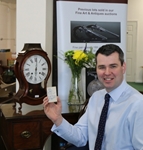
A Stowmarket auctioneer has announced it will be putting a very valuable piece of Beatles memorabilia up for sale next month.
Bishop & Miller, one of the region’s leading independent auction and valuation firms, will welcome bids for a band card autographed by the legendary foursome, worth an estimated £1,000-£1,500.
The sale will be the key highlight of Bishop & Miller’s first Toy and Memorabilia auction on March 10, which will also feature a number of other collectable items up for grabs.
The 55-year-old band card belongs to Mike Nicholson, a retired carpenter/joiner from King’s Lynn, who bagged the autographs at a Great Yarmouth gig way back in 1963.
Mr Nicholson, then a musician himself, luckily knew the stage manager at the concert who was able to meet the band backstage.
Source: Amy Gibbons/eadt.co.uk
details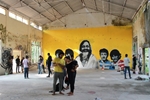
The year was 1968. Four hallowed visitors left the speedy life of London and reached Rishikesh, a city in India's northern state of Uttarakhand, located in the Himalayan foothills besides the holy river Ganges.
Beatlemania was in full swing then, but the Beatles themselves were grief-stricken over the sudden death of their manager and struggling to reboot their identity.
They were to learn Transcendental Meditation in the ashram of Maharishi Mahesh Yogi in a quest to find some inner peace.
The spiritually inclined George Harrison and John Lennon arrived in New Delhi on Feb. 16 and took the road towards the hill city for Maharishi's ashram.
Close behind them were practical-minded Paul McCartney, who was less sure about giving up his music and fame for an illusive mystical path, and Ringo Starr, the band's good-natured drummer, carrying suitcases full of Heinz baked beans in case the ashram's food failed to satisfy his appetite.
Source: english.kyodonews.netenglish.kyodonews.net
details
It's not uncommon for celebrity cars to pop up at auctions. Next month at the Goodwood Members' Meeting, the hammer will drop on Nick Mason's Ferrari Dino, Rod Stewart's Lamborghini Diablo and Paul McCartney's Lamborghini 400GT. But sometimes it's refreshing when the auctioned piece of Beatles memorabilia isn't a luxury car, but something else entirely.
A Honda Monkey. That's right, John Lennon used to have a Honda Monkey bike as well as a Mercedes 600 Pullman and a psychedelic Rolls-Royce. He bought the bike new in 1969, and used it to ride around the premises of his country house near Ascot, England. The 49cc Z50A is one of the earlier Monkeys, as the model line was originally introduced in the mid-Sixties and made commercially available in England by 1967. Monkeys or other Z-series mini bikes are still being made. The fantastic thing is that the bike is still as rough and dirty as Lennon left it, when he sold it in 1971, at the same time as he sold the house and moved to New York. In the early '70s, his celebrity status was so strong that the family purchasing the bike decided to just store it, instead of running it to the ground. Well, any further into the ground than Lennon had — there's certainly some patina details

A half-century ago, in a quest for fulfillment, the Beatles traveled to India and produced what would become a wildly popular double album. However, tensions that arose on that excursion foreshadowed the eventual breakup of the Fab 4, according to a band historian.
The 50th anniversary of what is widely known as the White Album, which was released to the public in November 1968, was the focus of a Feb. 15 talk at the Glencoe Public Library by Gary Wenstrup, a Beatles historian and lecturer.
"Glencoe is well ahead of the curve in terms of celebrating it," noted Wenstrup, who said he gives about 40 lectures a year on the iconic band.
Wenstrup told the story of how in the early part of 1968, Paul McCartney, John Lennon, George Harrison and Ringo Starr journeyed to India at the suggestion of Harrison's wife, Pattie, who had become intrigued with meditation and thought it could help everyone in a trying time.
While the Beatles had a major commercial success with Sgt. Pepper Lonely Hearts Club Band the year before, the price of fame was also eating away at them, compounded by the death of their manager, Brian Epstein, in August 1967.
"The Beatles had found that fame, fortune and drugs hadn't gi details

It’s not often that an artist has his work denigrated by the very subject of it and can laugh about it decades later. But that’s exactly what has happened to animator Ron Campbell, the director of “The Beatles” cartoon series. The Saturday morning show ran from 1965-69 and featured clean-cut, kid-friendly adventures of the Mop Tops set to their original recordings.
“I had heard that after the Beatles saw the show for the first time, John Lennon called it ‘that Flinstones shit,’” Campbell chuckles. “And then Ringo was upset and said ‘Oh, they made me the idiot!’ Which of course, we did. Poor guy!”
Campbell – a creative force in animation for more than five decades – will be making a stop in Houston at the Muir Fine Art Gallery. He’ll be selling and signing original artwork, prints, and posters—subjects including the Beatles and other cartoon favorites—and talking with fans.
Source: Bob Ruggiero/houstonpress.com
details
1968 was a year like no other, not least because it was the year The Beatles won four Grammys for an album like no other.
With Mark Phillips this morning, we'll be doing some time traveling:
Right from the first "ka-thump" of stylus hitting vinyl, and into the instrumental run-in to the first track … you knew the world would never be the same.
It was twenty years ago today
Sgt. Pepper taught the band to play…
It was fifty years ago this month, actually, that "Sgt. Pepper's Lonely Hearts Club Band" won four Grammys, including Album of the Year. But the album did more than win awards and set sales records; it divided time, between the world before "Sgt. Pepper" … and the world after.
It was more than just a different kind of album cover full of famous people. It was a different kind of album -- the concept album, performed by a different kind of band, a band that couldn't hear itself think, let alone play, over the screaming of its fans.
Source: CBS News
details
George was the greatest guy,” Tom Petty recalled in 2010, when I asked him about his friend and Traveling Wilburys bandmate, the late Beatle George Harrison. “He was funny, but he was tough, too. He didn’t suffer fools. I loved him like a brother and I still really miss him.”
A few years later, Ringo Starr echoed Petty’s sentiments. “George was a beautiful guy,” Starr told me in 2014. “He loved making music, and I loved making music with him.”
Harrison, who died in 2001, would have turned 75 on Feb. 25. But it’s not just his friends and contemporaries who recall him with fondness. In the years since his passing, the Beatle known as “the Quiet One” during the band’s 1960s heyday has been anything but. A steady but carefully curated stream of estate-sanctioned releases have helped burnish his memory recently, including several gorgeous box sets, a deluxe, expanded edition of his memoir, a Martin Scorcese directed documentary and, most recently, a spiffed up edition on vinyl and video of the tribute concert his all-star friends threw to celebrate his life, one year to the day after his death.
Source: nbcnews.com
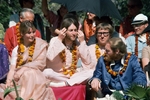
All you need to do is say this little word.
I know it sounds absurd but it's true.
The magic in the mantra will give you the answer.
And swallow this that's all you gotta do. So recommends the "Happy Rishikesh" song of The Beatles. The Beatles did swallow the mantra but whether and to what extent they got the answer is the moot point.
But one thing is for sure - their visit to Rishikesh to meditate in Maharishi Mahesh Yogi’s ashram from February to April in 1968, 50 years ago, was transformative in many respects. The beginning of The Beatles’ end began in the sylvan foothills of the Himalayas.
Later that year, they released the White Album - a double album in white sleeves with nary a graphic nor a text save the band’s name embossed on the cover. The recordings began in May.
The album cover was as dramatic in its simplicity as its predecessor Sgt Pepper’s Lonely Hearts Club Band’s was with its vivid colours and razzmatazz. The music reflected this simplicity and, as with the cover, stood out in stark contrast to the earlier offering. While Sgt Pepper’s was fuelled by LSD, the White Album was inspired by marijuana - most likely sourced locally.
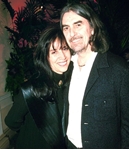
Paul McCartney and George Harrison's widow and son have publicly remembered the late Beatle on what would have been his 75th birthday.
"Happy Birthday Georgie. Wonderful memories," McCartney tweeted along with a black and white photograph of the two of them together during the Beatlemania days.
Harrison died of cancer in 2001 at the age of 58.
His widow, Olivia Harrison, and his son, Dhani Harrison, tweeted an invitation for fans to celebrate George's birthday by watching a video of Billy Preston and Eric Clapton performing the Harrison song "Isn't It a Pity" at the star-studded Concert for George in 2002.
McCartney and Ringo Starr are the only surviving members of the English band that rocketed to global fame in the 1960s. John Lennon was shot to death in 1980.
details
In the first week of July 1966, barely a month after George (Harrison) met Ravi Shankar for the first time, he along with the other members of the band were in Delhi, the Capital of India, for a brief 24-hour flying visit. Some weeks after he started his lessons, George had been told by his tutor
In the first week of July 1966, barely a month after George (Harrison) met Ravi Shankar for the first time, he along with the other members of the band were in Delhi, the Capital of India, for a brief 24-hour flying visit. Some weeks after he started his lessons, George had been told by his tutor that he needed to get a decent sitar which would be available only in India. Since the Beatles were planning their first tour of Asia in late June and early July, the plan was that on their return journey to England, George would get off in Delhi, buy a good sitar, spend a few days getting his first feel of India and then head back home to prepare for the band's tour of the United States some weeks later. After many twists and turns during a traumatic Asian tour, with the boys debating whether they too wanted to stop over in Delhi, fate took matters in hand and, almost as a fait accompli, brought all the Beatles to India for the first details

The "quiet Beatle" George Harrison would have turned 75 on February 25. A look back at the life of the boy from Liverpool who became the Fab Four's lead guitarist.
A brooder and introvert, George Harrison always seemed to be in the shadows of the alpha males John Lennon and Paul McCartney during his time with The Beatles. Yet he made it onto the Rolling Stone list of the 100 best guitarists of all time with his very special slide guitar technique at number 11.
The musical pioneer's legacy is "the combination of ritual Indian music with secular western pop music in the sense of a global music without ethnic or religious boundaries," said the curator of the rock'n'popmuseum in Gronau, Germany, Thomas Mania.
Source: Deutsche Welle/dw.com
details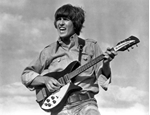
Former Beatle George Harrison would have turned 75 on Sunday and fellow guitarist Little Steven Van Zandt, from the E Street Band, is setting his alarm to celebrate.
Van Zandt, along with Bachman Turner Overdrive founder Randy Bachman and Ringo Starr’s musical director Mark Rivera, are meeting at E. 32nd St. venue The Cutting Room at 8 a.m. on Sunday for a visit with Ken Dashow, who hosts “Breakfast With The Beatles” on Q104.3.
“They will be telling their favorite George stories and strapping on some guitars to jam to a few Beatles tunes,” according to an insider tied to the appearance.
Van Zandt, a big Beatles fan, was joined on stage by Harrison’s old bandmate Paul McCartney during a November performance in London where the two of them performed a rousing rendition of “I Saw Her Standing There.” Video of that performance nearly broke the Internet. Harrison died in 2001 at 58 after a long battle with cancer.
Source: nydailynews.com
details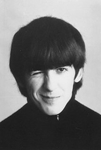
Former Beatles guitarist George Harrison would have turned 75 on Sunday, Feb. 25. Harrison was seen in various ways over his life. It is factual that he was the youngest of the four Beatles and the primary lead guitarist.
He also was pigeonholed at one point as the quiet Beatle, then as a curiosity when he started inserting Eastern Hemisphere music elements, such as the sitar instrument and a penchant for personal reflection, into his songs. The period from February to April 2018 marks the 50th anniversary of The Beatles spending time with yogis in India.
Beyond his Beatles years in the Sixties, Harrison had a wide ranging solo career. He dropped to a much lower profile after the late 1970s, then had a big comeback in 1988 with "Got My Mind Set On You" single and following work in the Traveling Wilburys supergroup, which included Bob Dylan and Tom Petty. Harrison died on Nov. 29, 2001, from lung cancer, less than two years after receiving wounds from a man who broke into his house and stabbed Harrison in the chest in December 1999.
Here are the top four charting songs by Harrison as a Beatle and solo artist, plus five extras that should not be overlooked.
Source: Bret Hayworth/siouxcityjournal.co details
